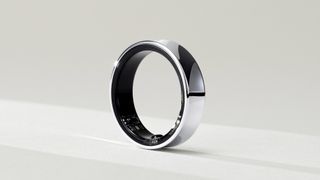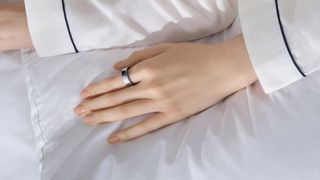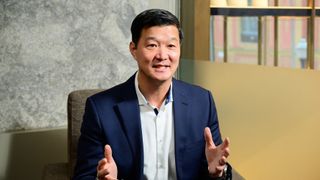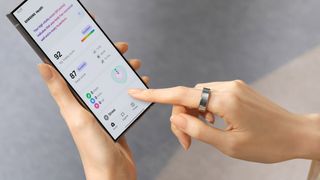I got my hands on an early Samsung Galaxy Ring prototype: here's what I learned
My first real hands-on with an early Samsung Galaxy Ring

I picked out the Samsung Galaxy Ring that fit my finger size and lifted it up to the light. The ring I had selected was a simple burnished gold-colored band that gleamed in the last of the Barcelona sun shining through the window, with several sensors and nodules on the black plastic inside to ensure good skin contact. Altogether, it didn’t look too dissimilar from a high-tech Lord of the Rings prop. But this ring – while it was unlikely to sprout fiery Elvish letters along the side – was just as coveted and secret, and I was one of the first journalists in the world to try it.
Or, at least, a version of it. The rings on display at my MWC 2024 roundtable interview with Samsung’s Chief Medical Officer, VP Dr. Hon Pak, were just non-functional prototypes, and we only got to wear them for a short time.
With the smallest ring weighing just 2.3g, they were incredibly light – perhaps too light, feeling as though they’d come out of a toy dispenser – and a little plasticky. These mock-up or prototype rings came in three colors: Ceramic Black, Platinum Silver, and Gold. When I asked whether the final version would be metal-plated or just colored plastic, a Samsung rep informed me we weren’t to know just yet.
That became somewhat of a theme: we weren’t to know how the sizing process would work, whether there would be a notch in the final design to ensure optimal sensor placement like the best smart rings use, or (crucially) how much it’s going to cost. Plenty of important details are still missing, and Samsung is currently in the final "refining" process, according to Pak, so the information below is, admittedly, subject to change.
However, I was able to glean lots of new information about the ring from Pak, starting with why it was made: sleep.
Sleep tracking and new metrics

Almost all of the emphasis during the presentation shown to me was on the Ring’s sleep-tracking credentials. The Ring offers four additional advanced sleep insights that a smartwatch doesn’t: resting heart rate during sleep, respiratory rate, night movement, and sleep latency.
A Vitality score also collects data about physical and mental readiness, developed with machine learning in collaboration with the University of Georgia, combining overall sleep, activity, resting heart rate, and HRV to get a single number.
Get daily insight, inspiration and deals in your inbox
Sign up for breaking news, reviews, opinion, top tech deals, and more.
“We can look at large sets of data, with permission… and study and use that data for the good of the population," said Pak. “What I’ve come to realize is that sleep is a window to your health. We know things like, for example, deep and REM sleep correlate strongly with dementia. And we are beginning to understand the implications of sleeping well and physiological patterns. We’ve been collecting that data and hopefully, it’ll have huge implications for the users.”
It sounds like the Vitality score is going to work a lot like the Readiness scores used by the Oura Ring and the Training Readiness score on the best Garmin watches, only powered by Large Language Models instead of the algorithms used by Oura and Garmin.
Watch: Here's what we though about the Galaxy Ring
@techradar ♬ original sound - TechRadar
Most of the emphasis of the presentation was on the Samsung Galaxy Ring’s sleep benefits, including the much more comfortable form factor, as a ring is far less annoying than a smartwatch during sleep. I certainly found this one comfortable to wear even during my brief trial; it doesn’t irritate, even with the protruding plastic-skin contact nodules, and we were offered the choices of Ring sizes 5-13 – enough comfort for every journalist there.
The sleep innovations don’t stop there: sleep apnoea detection is present too, and Pak even envisions a future where the Ring one day connects to a smart mattress that thermo-regulates. If the Ring uses its temperature sensor to detect the body is too hot, the mattress will drop in temperature automatically. Pak spoke confidently and passionately about this, leading me to think this is a project perhaps in serious development.
Simplified approach and data privacy

The Ring represents “a comprehensive and simplified approach” to health and sleep, says Pak, one without the barriers of operating a watch, and which relies on AI to do all the legwork for you.
“We finally heard our users and consumers saying ‘I want choice. I want flexibility.' And for some, simpler is better,” said Pak. “We’re giving a choice to wear the Ring either with the smartwatch or without it. Unless you choose to wear it, there’s no data. Style and comfort matter, and there is a set of people who say ‘they can’t wear a watch’.”
The Ring seems simple: like other smart rings, there are no buttons, no screens, no surface LEDs, or ways to interact with the ring in any way. The prototype I got to try was a solid chunk of plastic that passively observes your health and sends the data to your smartphone. There is no pressing a button or interacting with it in the same way as the watch.
Incidentally, although the data is shown on your smartphone in the form of scores and stats, the data crunching usually stays on-device. Pak said that Samsung Knox security protocols will be applied to the data collected, including menstrual cycle data.
The Ring has a skin temperature sensor and will be able to track women's cycles, and Samsung has partnered with the Natural Cycles app to improve its period-tracking capabilities. Like other smart rings such as Evie, it'll be great for women's health, although it comes without other considerations: Evie has a break in its Ring design to provide flexibility and take into account the fluctuations of women's bodies. Data privacy remains a concern for many women, especially in the US, and Pak claims that “our commitment to data privacy is ongoing despite any new devices released.”
Known specs, colors and more

While we don’t have prices, battery life, or release date (“second half” of the year, according to Pak), we do know quite a bit more than when we started the briefing. The Ring has a concave design to avoid surface scratches, functioning just like the raised bezel used to protect the faces of some of the best running watches. Scratching is a problem we’ve found with several convex designs, mostly the Ultrahuman Ring Air, so it’s good to see Samsung address this.
The Ring will track steps and movement. While I don’t know exactly what the battery life will be (“I can’t tell you [how long the ring lasts] because the product is still evolving”), the battery listed on the Ring ranges from 14.5mAh to 21.5mAh, depending on size. It’ll weigh between 2.3-2.9g, also depending on size. It’s got those aforementioned three colors right now: Ceramic Black, Platinum Silver, and Gold, although as ever, these are subject to change.
It packs in a lot of the Samsung Galaxy Watch's sensors in miniature, including an SPO2 blood oxygen sensor, and you do get additional benefits by wearing the Watch and Ring together: sleep stages are more accurate.
While I learned a lot, we only actually got to wear the prototypes for a few minutes, and unfortunately, no photos were allowed. It wasn’t linked to a phone, so I couldn’t see any of the new metrics, and some of the details are still being refined. So while I can’t give you a full review, or tell you how it works in practice, I can tell you this is a stepping stone for Samsung, and we're witnessing an evolution of its health-based devices.
It’s also no afterthought: it was a very comprehensive presentation, and Samsung’s clearly putting a lot of thought into the Ring and where it sits in Samsung’s ecosystem. Overall, I like what I see so far, although I’m still wondering if I can get the gold one engraved with a bit of Elvish.
You might also like...

Matt is TechRadar's expert on all things fitness, wellness and wearable tech. A former staffer at Men's Health, he holds a Master's Degree in journalism from Cardiff and has written for brands like Runner's World, Women's Health, Men's Fitness, LiveScience and Fit&Well on everything fitness tech, exercise, nutrition and mental wellbeing.
Matt's a keen runner, ex-kickboxer, not averse to the odd yoga flow, and insists everyone should stretch every morning. When he’s not training or writing about health and fitness, he can be found reading doorstop-thick fantasy books with lots of fictional maps in them.
Most Popular

